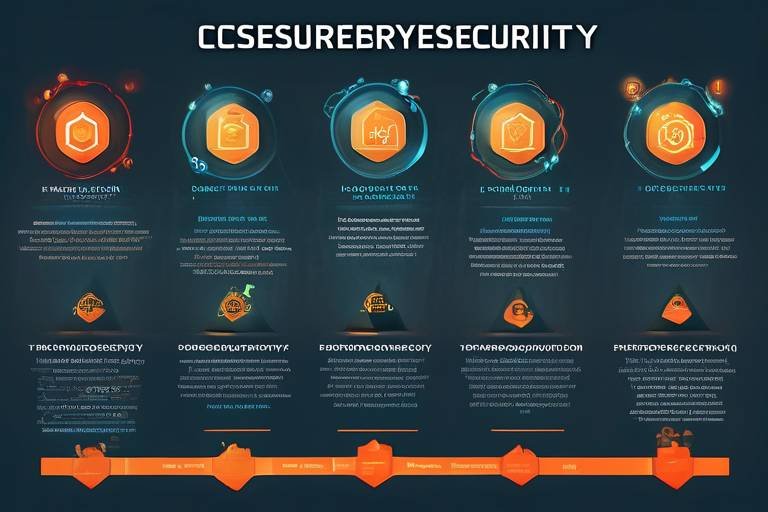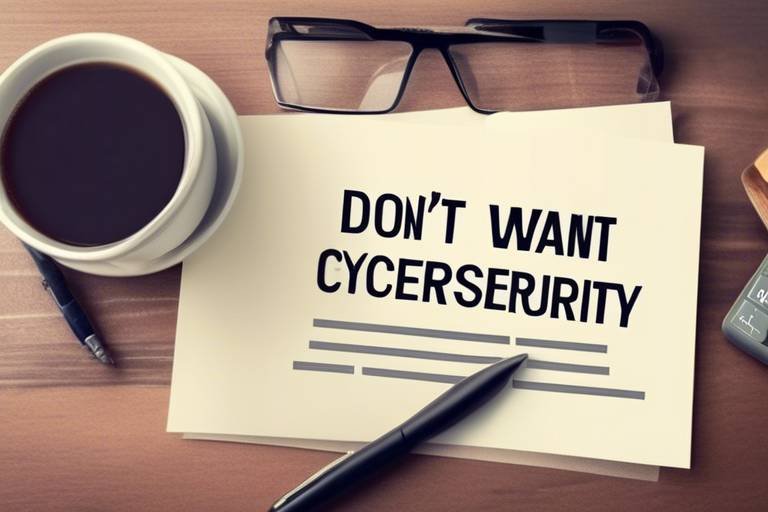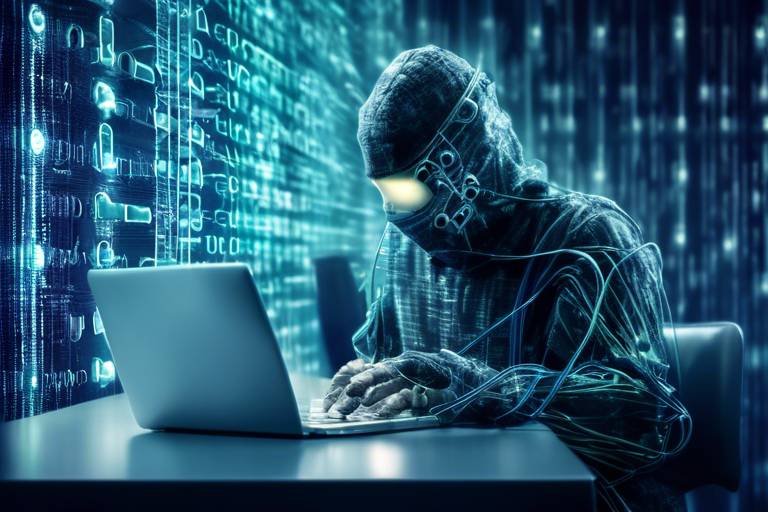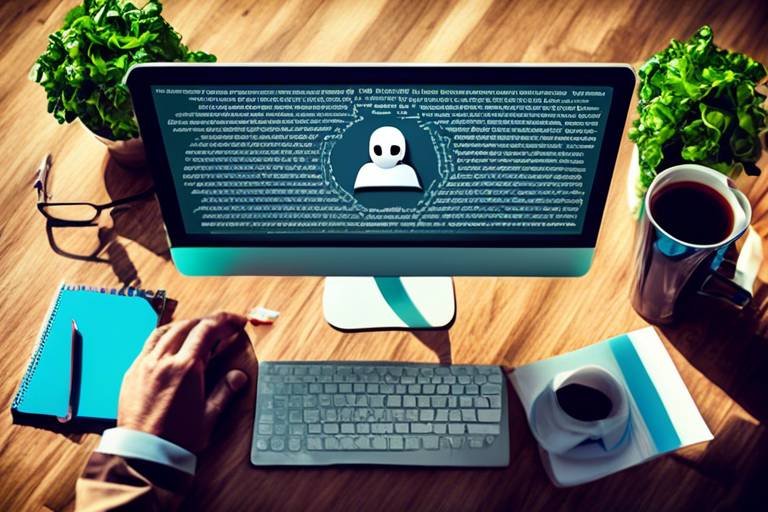The Evolution of Cybersecurity
The digital world has transformed dramatically over the past few decades, leading to an unprecedented reliance on technology in our daily lives. With this transformation, the need for robust cybersecurity has become more critical than ever. Cybersecurity is not just a technical term; it embodies a complex interplay of technology, human behavior, and regulatory frameworks designed to protect our data and systems. As we delve into the historical development of cybersecurity, we will uncover key milestones, emerging threats, and the technological advancements that have shaped this essential field.
In the early days of computing, cybersecurity was almost an afterthought. Imagine a time when computers were rare, and the internet was just a concept! Back then, the idea of hacking was more of a hobby than a criminal activity. However, as computers became more widespread, so did the need for security. The initial measures were rudimentary—often limited to basic passwords and physical security. But as the landscape of technology evolved, so too did the threats, leading to a fascinating journey of innovation and adaptation in cybersecurity.
Fast forward to today, and we find ourselves in a world where cyber threats are not only sophisticated but also pervasive. The evolution of cybersecurity has been marked by significant events and innovations that have shaped its current state. From the rise of malware to the establishment of stringent data protection laws, the journey has been anything but straightforward. As we explore the various phases of this evolution, we will not only highlight the challenges faced but also celebrate the advancements made in safeguarding our digital lives.
So, buckle up as we take a closer look at the early days of cybersecurity, the rise of malware, the impact of legislation, and what the future may hold for this ever-evolving field. Each section will provide insights into how we got here and where we might be heading, ensuring that you are well-informed about the intricacies of cybersecurity.
In the initial stages of computing, cybersecurity was minimal. This section discusses the primitive security measures and the first instances of cyber threats that emerged alongside early computer systems. The landscape was largely uncharted, with few individuals understanding the vulnerabilities present in their systems. Early computer users often relied on the assumption that their machines were safe, resulting in a lack of proactive security measures.
As technology progressed, the first cyber threats began to surface, albeit in a rudimentary form. These included simple forms of unauthorized access and basic data corruption. The early hackers were often motivated by curiosity rather than malicious intent, leading to the first instances of what we now recognize as cybercrime. These events laid the groundwork for the cybersecurity measures that would eventually become essential.
As technology advanced, so did the complexity of cyber threats. The emergence of malware marked a significant turning point in the cybersecurity landscape. Malware comes in various forms, including viruses, worms, and trojans, each designed to exploit vulnerabilities in computer systems. The impact of malware on organizations and individuals has been profound, leading to significant financial losses and data breaches.
The introduction of computer viruses was a pivotal moment in the history of cybersecurity. The first known virus, Elk Cloner, appeared in the early 1980s and spread through floppy disks. Its creators were not malicious; they were merely testing the boundaries of what was possible. However, the consequences were far-reaching, raising awareness about the need for better security practices.
In 1988, the Morris Worm became one of the first major worms to disrupt the internet. This incident highlighted vulnerabilities in networked systems and prompted a reevaluation of cybersecurity practices. The worm infected approximately 6,000 computers, leading to significant downtime and loss of productivity. The Morris Worm incident served as a wake-up call for both individuals and organizations, emphasizing the need for improved security measures.
In response to the growing threats posed by malware, early antivirus software began to emerge. These tools were designed to detect and eliminate viruses before they could cause harm. However, the effectiveness of these early solutions varied, as they often struggled to keep pace with the rapidly evolving malware landscape. Nevertheless, they laid the foundation for the sophisticated antivirus solutions we rely on today.
As cyber threats evolved, so did the strategies to combat them. The development of firewalls, intrusion detection systems, and encryption technologies marked significant advancements in cybersecurity measures. Firewalls act as a barrier between trusted internal networks and untrusted external networks, while intrusion detection systems monitor network traffic for suspicious activity. Encryption, on the other hand, ensures that sensitive data remains secure, even if intercepted.
Government regulations have played a crucial role in shaping cybersecurity practices. Key legislation and policies have influenced how organizations approach cybersecurity, ensuring that they prioritize the protection of sensitive data. For instance, the General Data Protection Regulation (GDPR) has established strict guidelines for handling personal information, compelling organizations to adopt robust security measures.
Data protection laws, such as GDPR, have established strict guidelines for handling personal information. These laws have had a profound impact on cybersecurity practices globally, forcing organizations to rethink their data management strategies. Non-compliance can result in hefty fines, further incentivizing businesses to prioritize cybersecurity.
Various frameworks have been developed to guide organizations in implementing effective cybersecurity measures. These frameworks serve as blueprints, providing best practices and guidelines to enhance security protocols. Popular frameworks such as the NIST Cybersecurity Framework and ISO/IEC 27001 have become essential in helping organizations navigate the complex cybersecurity landscape.
Looking ahead, the future of cybersecurity is both exciting and daunting. Emerging trends and technologies, including artificial intelligence and machine learning, are set to revolutionize the field. As cyber threats continue to evolve, the need for innovative solutions will become increasingly important. Organizations must remain vigilant and adaptable, ready to face the challenges posed by an ever-changing threat landscape.
- What is cybersecurity? Cybersecurity involves protecting computer systems and networks from theft, damage, or unauthorized access.
- Why is cybersecurity important? With the increasing reliance on technology, cybersecurity is essential to protect sensitive data and maintain trust in digital systems.
- What are the common types of cyber threats? Common threats include malware, phishing attacks, ransomware, and denial-of-service attacks.
- How can individuals protect themselves online? Individuals can enhance their cybersecurity by using strong passwords, enabling two-factor authentication, and being cautious of suspicious emails and links.

The Early Days of Cybersecurity
The journey of cybersecurity began in the early days of computing, a time when the concept of protecting data was almost non-existent. Picture this: computers were bulky machines, often found in large rooms, and the internet was merely a fledgling idea. In these primitive stages, security measures were as basic as a lock on a door—more of a suggestion than a necessity. The idea of cyber threats was so foreign that many users didn't even consider the need for protection. This was a time when a simple password could be the only barrier between your data and an unauthorized user.
As computers began to connect with one another, the first whispers of cyber threats emerged. Early hackers saw these systems as playgrounds, experimenting without a clear understanding of the consequences. The absence of robust security measures meant that the first instances of cyber threats were often more mischievous than malicious. For example, simple pranks like changing the display names of files or sending annoying pop-ups were common. However, these early antics laid the groundwork for a more serious approach to cybersecurity.
One of the first notable threats came in the form of the “Creeper” program, which appeared in the early 1970s. This self-replicating program would move across ARPANET, displaying the message, “I’m the creeper, catch me if you can!” While it was more of a curiosity than a threat, it highlighted the potential for more harmful actions. In response, the first antivirus program, “Reaper,” was created to delete Creeper, marking a significant milestone in the evolution of cybersecurity.
As the 1980s rolled in, the landscape of computing began to change dramatically. Personal computers became more accessible, and with this accessibility came the need for better security. The rise of bulletin board systems (BBS) and early online services like CompuServe and AOL introduced new vulnerabilities. Users began to share files, often without understanding the risks involved. This era saw the emergence of the first real cyber threats that could cause damage, leading to a growing awareness of the need for cybersecurity measures.
To combat these emerging threats, early security measures were developed, albeit rudimentary. Some of these measures included:
- Password protection: Users were encouraged to create strong passwords, although many still opted for easily guessable ones.
- File permissions: Early operating systems introduced the concept of file permissions, allowing users to restrict access to certain files.
- Backup systems: The importance of backing up data became apparent as users experienced data loss due to accidental deletions or early malware.
Despite these initial attempts at cybersecurity, the reality was that most users remained oblivious to the threats lurking in the digital shadows. The early days of cybersecurity were characterized by a sense of innocence, where the focus was primarily on innovation rather than protection. However, as the internet evolved and more people began to rely on digital systems, the need for comprehensive cybersecurity measures became increasingly apparent. This marked the beginning of a long and complex journey toward the sophisticated cybersecurity landscape we navigate today.

The Rise of Malware
As technology advanced, so did the complexity of cyber threats, leading to a significant evolution in the landscape of cybersecurity. The emergence of malware—malicious software designed to harm or exploit any programmable device or network—marked a new era in the digital world. This shift was not just about the introduction of new software; it represented a fundamental change in how individuals and organizations interacted with technology. The stakes were raised as the internet became more accessible, and the potential for exploitation became evident.
Malware comes in various forms, each with its own unique capabilities and purposes. Some of the most notorious types include:
- Viruses: These attach themselves to legitimate programs and spread when the infected program is executed.
- Worms: Unlike viruses, worms can replicate themselves and spread independently across networks.
- Trojans: These disguise themselves as legitimate software but carry harmful payloads once executed.
- Ransomware: This type encrypts a user's files and demands payment for the decryption key.
- Spyware: This secretly monitors user activity and collects sensitive information without consent.
The impact of malware on organizations and individuals has been profound. In the early days, malware was often seen as a nuisance, but as its capabilities grew, so did its potential for damage. Businesses faced not only financial losses due to data breaches and system downtime but also reputational damage that could take years to recover from. The emergence of ransomware, for instance, has led to organizations being held hostage, with cybercriminals demanding exorbitant fees to restore access to critical data.
Moreover, the rise of malware has forced organizations to rethink their cybersecurity strategies. The realization that traditional security measures were insufficient led to a frantic race for more sophisticated defenses. Companies began investing heavily in cybersecurity solutions, including advanced threat detection systems and employee training programs to raise awareness about potential threats. This shift was akin to fortifying a castle after realizing that the gates were wide open, inviting attackers in.
The growing sophistication of malware has also led to a more collaborative approach within the cybersecurity community. Organizations started sharing information about threats and vulnerabilities, recognizing that a unified front was essential in combating the ever-evolving landscape of cyber threats. This collaboration is crucial, as it allows for the rapid identification and mitigation of new malware strains, helping to protect not just individual companies but the entire digital ecosystem.
In summary, the rise of malware has transformed the cybersecurity landscape, pushing organizations to adapt and innovate in their defensive strategies. As we continue to rely on technology for everyday tasks, the importance of understanding and combating malware cannot be overstated. The digital age has ushered in a new era of challenges, but with awareness and proactive measures, we can better safeguard our digital lives.
- What is malware?
Malware is malicious software designed to harm or exploit any programmable device or network. It includes viruses, worms, Trojans, ransomware, and spyware. - How does malware spread?
Malware can spread through various means, including infected email attachments, malicious downloads, and compromised websites. - What should I do if my device is infected with malware?
If you suspect malware infection, disconnect from the internet, run a full antivirus scan, and seek professional help if necessary. - Can malware be prevented?
While no solution is foolproof, keeping software updated, using reputable antivirus programs, and practicing safe browsing habits can significantly reduce the risk of infection.

The First Computer Viruses
When we think of the early days of computing, the concept of a computer virus might seem like something out of a science fiction novel. However, the reality is that these malicious programs emerged almost as soon as computers began to communicate with one another. The first known computer virus, known as Elk Cloner, was created in 1982 by a high school student named Rich Skrenta. This virus was not designed to cause harm but rather as a prank. It spread via floppy disks and displayed a poem on the 50th boot of the infected machine. While it may have started as a harmless joke, Elk Cloner set the stage for a much darker evolution of computer threats.
As technology progressed, so did the sophistication of these viruses. The late 1980s saw the emergence of more damaging viruses such as Brain, which was created in Pakistan and spread through infected floppy disks. Unlike Elk Cloner, Brain had a malicious intent—it aimed to infect the boot sector of the disk and was designed to be a form of piracy protection for a software company. This marked a pivotal moment in cybersecurity history, as it raised awareness about the potential for software to be compromised.
One of the most notorious early viruses was the Morris Worm, released in 1988 by Robert Tappan Morris. This worm was significant not only for its technical implications but also for the chaos it caused on the early internet. It exploited vulnerabilities in UNIX systems and spread rapidly, affecting approximately 10% of the internet at the time. The Morris Worm incident highlighted the urgent need for improved security measures and sparked a new wave of awareness and research into cybersecurity.
In response to the growing threat of computer viruses, the cybersecurity community began to develop antivirus solutions. Early antivirus programs were rudimentary, often relying on signature-based detection methods. They would scan files for known virus signatures and attempt to remove them. However, as the number of viruses grew, so did the complexity of antivirus solutions. Today, antivirus software employs a combination of techniques, including heuristic analysis and behavioral detection, to combat the ever-evolving landscape of malware.
In summary, the emergence of the first computer viruses marked a watershed moment in the field of cybersecurity. These early threats not only demonstrated the vulnerabilities inherent in computer systems but also underscored the need for robust security measures. As we continue to navigate an increasingly digital world, understanding the origins of these threats is crucial in developing effective defenses against them.
- What was the first computer virus? The first known computer virus is Elk Cloner, created in 1982.
- How did the Morris Worm impact cybersecurity? The Morris Worm highlighted the vulnerabilities of the early internet and led to increased awareness and research in cybersecurity.
- What are modern antivirus solutions? Modern antivirus solutions utilize a combination of signature-based detection, heuristic analysis, and behavioral detection to combat malware.

The Morris Worm Incident
The Morris Worm, unleashed in 1988 by Robert Tappan Morris, is often regarded as one of the first significant cyber incidents that shook the digital world. This worm was not just a simple piece of malicious code; it was a harbinger of the complex cybersecurity challenges that lay ahead. It exploited vulnerabilities in UNIX systems, particularly targeting a flaw in the sendmail program, along with other weaknesses. The result? A staggering number of computers became infected, leading to a massive slowdown of the internet.
Imagine waking up one morning to discover that your computer, which was once a reliable tool, had turned into a sluggish machine, barely able to perform basic tasks. This was the reality for many users in 1988. The worm replicated itself so aggressively that it caused approximately 10% of the internet to be affected at its peak. The implications of this incident were profound, as it highlighted just how vulnerable systems were to attacks, even those that seemed benign at first glance.
One of the most alarming aspects of the Morris Worm incident was the lack of preparedness among organizations. At that time, cybersecurity was still in its infancy, and many entities had not implemented adequate security measures. This incident served as a wake-up call, emphasizing the need for robust cybersecurity protocols. In response, organizations began to realize that they could no longer afford to be complacent; they needed to adopt a proactive stance against potential threats.
Furthermore, the Morris Worm incident led to significant changes in how cybersecurity was perceived and managed. It catalyzed the development of various security measures, including:
- Increased Awareness: Organizations began to educate their employees about the importance of cybersecurity.
- Development of Security Tools: This incident prompted the creation of more sophisticated antivirus and anti-malware solutions.
- Formation of Incident Response Teams: Companies started to establish dedicated teams to respond to cybersecurity incidents swiftly.
In retrospect, the Morris Worm incident was more than just a technical failure; it was a pivotal moment that underscored the need for comprehensive cybersecurity strategies. It laid the groundwork for future advancements in the field, shaping how organizations approach security today. By learning from the past, we can better prepare for the challenges that lie ahead in the ever-evolving landscape of cybersecurity.
- What was the Morris Worm?
The Morris Worm was one of the first computer worms distributed via the internet, created by Robert Tappan Morris in 1988. It exploited vulnerabilities in UNIX systems and caused significant disruptions across the network.
- What impact did the Morris Worm have on cybersecurity?
The incident highlighted the vulnerabilities in computer systems, leading to increased awareness and the development of better security measures and tools.
- How did organizations respond to the Morris Worm?
Organizations began to implement more robust cybersecurity protocols, including employee training, the development of antivirus software, and the establishment of incident response teams.

Early Antivirus Solutions
As the digital landscape began to evolve and the threats posed by malware became more pronounced, the need for effective defensive measures became apparent. In the late 1980s and early 1990s, the emergence of computer viruses prompted a frantic search for solutions, leading to the development of early antivirus software. These initial tools were rudimentary at best, often relying on simple signature-based detection methods. They operated under the assumption that if they could recognize the unique code of a virus, they could neutralize it before it caused any damage.
One of the first antivirus programs to gain widespread recognition was VirusScan, developed by John McAfee in 1987. This software marked a significant milestone in cybersecurity, as it was one of the first to offer real-time scanning capabilities. However, the effectiveness of these early solutions was often hampered by the rapidly changing nature of malware. As new viruses emerged, antivirus developers had to scramble to update their databases, which led to a constant game of catch-up.
Another notable player in the antivirus market was Symantec, which introduced Norton Antivirus in 1991. Norton quickly became a household name, known for its user-friendly interface and robust features. It utilized heuristics, a method that allowed the software to identify potential threats based on behavior rather than just known signatures. This was a game changer, as it enabled Norton Antivirus to detect new and unknown threats, providing a more proactive approach to cybersecurity.
Despite these advancements, early antivirus solutions faced significant challenges. The sheer volume of malware was overwhelming, and many users were unaware of the importance of keeping their antivirus software updated. In fact, a study conducted in the early 90s revealed that less than 30% of computer users had any form of antivirus protection installed. This lack of awareness contributed to a growing number of infections, which in turn fueled the development of more sophisticated malware.
To illustrate the evolution of early antivirus solutions, we can look at a comparison table of some of the pioneering antivirus programs:
| Antivirus Software | Year Introduced | Key Features |
|---|---|---|
| VirusScan | 1987 | Real-time scanning, signature-based detection |
| Norton Antivirus | 1991 | User-friendly interface, heuristic detection |
| Dr. Solomon's Antivirus Toolkit | 1993 | Comprehensive virus scanning, removal tools |
As the years progressed, it became clear that antivirus software needed to evolve continuously. The early solutions laid the groundwork, but the rapid pace of technological advancement and the sophistication of cyber threats demanded more innovative approaches. This realization led to the integration of features such as automatic updates, cloud-based scanning, and behavioral analysis, which are now standard in modern antivirus solutions.
In conclusion, the early antivirus solutions were crucial in the fight against malware, even if they were not foolproof. They sparked a revolution in cybersecurity, highlighting the necessity of protective measures in an increasingly digital world. As we reflect on these early days, it's evident that the foundations laid by these pioneering tools continue to influence the development of contemporary cybersecurity practices.
- What was the first antivirus software? The first widely recognized antivirus software was VirusScan, developed by John McAfee in 1987.
- How did early antivirus solutions detect viruses? Early antivirus solutions primarily used signature-based detection methods, identifying known virus codes to neutralize threats.
- Why were early antivirus solutions ineffective? Many early solutions struggled with the rapid emergence of new malware and lacked user awareness for regular updates.
- What advancements have been made in antivirus technology? Modern antivirus solutions now include features like real-time scanning, cloud-based detection, and behavioral analysis to combat evolving threats.

Evolution of Cybersecurity Measures
As the digital landscape expanded, so did the sophistication of cyber threats, prompting a corresponding evolution in cybersecurity measures. Initially, organizations relied on basic password protection and physical security to safeguard their systems. However, as cybercriminals became more innovative, these rudimentary measures proved insufficient. The need for more robust defenses led to the development of various cybersecurity technologies and strategies that have transformed the way we protect our digital assets.
One of the first significant advancements in cybersecurity was the introduction of firewalls. Acting as a barrier between trusted internal networks and untrusted external networks, firewalls monitor incoming and outgoing traffic based on predetermined security rules. They can be hardware-based, software-based, or a combination of both, and they play a crucial role in preventing unauthorized access to sensitive information. Over time, firewalls have evolved to include features like intrusion detection systems (IDS), which actively monitor network traffic for suspicious activity and alert administrators to potential threats.
Another key development in cybersecurity measures is the implementation of encryption. Encryption transforms readable data into an unreadable format, ensuring that even if unauthorized individuals gain access to sensitive information, they cannot decipher it without the appropriate decryption key. This technology is vital for protecting data in transit, such as during online transactions, and at rest, like information stored on servers. With the rise of cloud computing, encryption has become even more critical, as organizations need to ensure that their data remains secure while being stored off-site.
Moreover, the advent of multi-factor authentication (MFA) has significantly enhanced security protocols. MFA requires users to provide two or more verification factors to gain access to a system, making it exponentially harder for cybercriminals to breach accounts. This can include something the user knows (like a password), something the user has (like a smartphone), or something the user is (like a fingerprint). By adding these layers of security, organizations can better protect their sensitive information from unauthorized access.
In addition to these technological advancements, the evolution of cybersecurity measures has also seen a shift towards a more comprehensive approach known as cyber resilience. This strategy emphasizes not only the protection of systems but also the ability to respond to and recover from cyber incidents. Organizations are now focusing on developing incident response plans, conducting regular security audits, and implementing employee training programs to foster a culture of cybersecurity awareness. This holistic approach ensures that everyone within the organization plays a role in maintaining security, rather than leaving it solely to the IT department.
The evolution of cybersecurity measures is ongoing, as new technologies and threats continue to emerge. For instance, the rise of artificial intelligence (AI) and machine learning is beginning to reshape the landscape once again. These technologies can analyze vast amounts of data to identify patterns and anomalies, enabling organizations to detect threats in real-time and respond more effectively. As we look to the future, it is clear that the evolution of cybersecurity will be driven by the need for greater sophistication and adaptability in the face of an ever-changing threat landscape.
- What is a firewall? A firewall is a network security device that monitors and controls incoming and outgoing network traffic based on predetermined security rules.
- Why is encryption important? Encryption protects sensitive data by converting it into an unreadable format, ensuring that unauthorized individuals cannot access or understand the information.
- What is multi-factor authentication? Multi-factor authentication (MFA) is a security measure that requires users to provide two or more verification factors to gain access to a system, enhancing account security.
- What is cyber resilience? Cyber resilience is an approach that focuses on not just protecting systems but also preparing for, responding to, and recovering from cyber incidents.

The Impact of Legislation
When we think about the world of cybersecurity, it’s easy to get lost in the technical jargon and the latest malware threats. However, one of the most significant influences on how organizations protect their data comes from government legislation. Laws and regulations are like the rules of a game; they set the boundaries within which organizations must operate. Over the years, various laws have emerged to shape the cybersecurity landscape, compelling companies to adopt stronger security measures and protect sensitive information.
Take, for instance, the General Data Protection Regulation (GDPR), which came into effect in May 2018. This regulation not only transformed how organizations handle personal data but also introduced hefty fines for non-compliance. Imagine a company that neglects to secure its customer data; under GDPR, they could face fines of up to €20 million or 4% of their global revenue, whichever is higher! This kind of financial risk has pushed many organizations to rethink their cybersecurity strategies, making them more robust and comprehensive.
Another critical piece of legislation is the Health Insurance Portability and Accountability Act (HIPAA), which mandates strict security measures for healthcare organizations to protect patient information. The implications of failing to comply with HIPAA can be dire, not just financially but also in terms of trust. Patients expect their sensitive health information to be protected, and any breach can lead to a loss of confidence in healthcare providers.
Here’s a quick overview of some key legislation impacting cybersecurity:
| Legislation | Year Enacted | Key Focus |
|---|---|---|
| GDPR | 2018 | Data protection and privacy for individuals within the EU |
| HIPAA | 1996 | Protection of patient health information |
| California Consumer Privacy Act (CCPA) | 2020 | Consumer rights regarding personal information |
| Federal Information Security Management Act (FISMA) | 2002 | Information security for federal agencies |
As we can see, legislation not only sets the tone for how organizations should handle data but also serves as a wake-up call for those who might be complacent about cybersecurity. Non-compliance can lead to significant legal repercussions, which is a powerful motivator for companies to invest in cybersecurity measures. The impact of legislation extends beyond just compliance; it fosters a culture of security awareness and accountability within organizations.
Moreover, legislation often drives innovation in cybersecurity technology. As companies scramble to meet regulatory requirements, they often turn to new technologies, such as encryption, multi-factor authentication, and advanced threat detection systems. These innovations not only help companies comply with laws but also enhance their overall security posture, making it more difficult for cybercriminals to exploit vulnerabilities.
In conclusion, the interplay between legislation and cybersecurity is a dynamic one. As cyber threats continue to evolve, so too will the laws that govern our digital landscape. Organizations must stay informed and agile, adapting to new regulations while also proactively enhancing their cybersecurity measures. After all, in the game of cybersecurity, being ahead of the curve can make all the difference.
- What is GDPR? GDPR stands for General Data Protection Regulation, a law that protects personal data and privacy in the European Union.
- How does HIPAA affect cybersecurity? HIPAA mandates strict security measures for healthcare organizations to protect patient information, making compliance essential for trust and legal protection.
- What are the penalties for non-compliance with cybersecurity laws? Penalties can vary widely, including fines, legal action, and loss of customer trust, depending on the specific legislation.

Data Protection Laws
In today's digital age, have become a cornerstone of cybersecurity practices. These laws are designed to safeguard personal information and ensure that organizations handle data responsibly. One of the most significant pieces of legislation in this arena is the General Data Protection Regulation (GDPR), which was enacted by the European Union in 2018. GDPR has set a new standard for data privacy, not just in Europe but worldwide, forcing companies to rethink their data handling practices.
The GDPR is not just a set of rules; it's a comprehensive framework that emphasizes the rights of individuals regarding their personal information. Under GDPR, individuals have the right to access their data, request corrections, and even demand deletion of their information. This shift places a significant burden on organizations to ensure compliance, as the penalties for non-compliance can be severe—up to €20 million or 4% of global turnover, whichever is higher. This has led many companies to invest heavily in their cybersecurity measures to avoid such penalties.
But GDPR is not the only data protection law making waves. Around the globe, various countries have started to implement their own regulations. For instance, the California Consumer Privacy Act (CCPA) gives California residents the right to know what personal data is being collected about them and how it is used. Similarly, countries like Brazil and Canada have introduced their own data protection laws, reflecting a global trend towards stricter data privacy regulations.
These laws not only protect individuals but also shape how organizations approach cybersecurity. Companies now need to adopt a proactive stance in securing personal data. This includes implementing robust data security measures, conducting regular audits, and training employees on data protection policies. Failure to comply can lead to legal repercussions, loss of customer trust, and significant financial damage.
To illustrate the impact of these laws, consider the following table that summarizes key data protection laws around the world:
| Country/Region | Law | Key Features |
|---|---|---|
| European Union | GDPR | Rights to access, rectification, erasure; hefty fines for non-compliance |
| United States (California) | CCPA | Right to know, delete data, opt-out of data selling |
| Brazil | LGPD | Similar to GDPR; focuses on data subject rights and consent |
| Canada | PIPEDA | Regulates how private sector organizations collect, use, and disclose personal information |
As we move forward, it's clear that data protection laws will continue to evolve, and organizations must stay ahead of the curve. The challenge lies not only in compliance but in creating a culture of data protection within organizations. This involves ongoing training, awareness programs, and a commitment to transparency. In the end, the goal is to protect individuals' rights while ensuring that businesses can operate effectively in a data-driven world.
In conclusion, the landscape of data protection laws is rapidly changing, and organizations must adapt to these changes to ensure they remain compliant and protect their customers' personal information. The intersection of legislation and cybersecurity is more critical than ever, and understanding this relationship is essential for any organization looking to thrive in the digital age.
- What is the purpose of data protection laws? Data protection laws aim to safeguard personal information and ensure organizations handle data responsibly.
- How does GDPR affect businesses outside the EU? GDPR applies to any organization that processes the personal data of EU residents, regardless of where the organization is based.
- What are the penalties for non-compliance with data protection laws? Penalties can include hefty fines, legal repercussions, and damage to reputation.
- How can organizations ensure compliance with data protection laws? Organizations can ensure compliance by implementing robust data security measures, conducting regular audits, and training employees on data protection policies.

Cybersecurity Frameworks
In today's digital landscape, the importance of cannot be overstated. These frameworks serve as a structured approach for organizations to manage and mitigate cybersecurity risks effectively. Think of them as the blueprints for building a secure digital fortress. Just as a strong foundation is vital for a building, a solid cybersecurity framework is essential for safeguarding sensitive data and maintaining trust with customers and stakeholders.
One of the most widely recognized frameworks is the NIST Cybersecurity Framework, developed by the National Institute of Standards and Technology. This framework provides a comprehensive set of guidelines that help organizations identify, protect, detect, respond to, and recover from cyber threats. The NIST framework is particularly valuable because it is flexible and can be tailored to fit the specific needs and risk profiles of different organizations.
Another notable framework is the ISO/IEC 27001, an international standard that outlines the requirements for establishing, implementing, maintaining, and continually improving an information security management system (ISMS). This framework emphasizes the importance of risk management and aligns with global best practices, making it a preferred choice for many multinational corporations.
Organizations often choose to implement these frameworks not just for compliance, but to foster a culture of security awareness among employees. By adopting a cybersecurity framework, companies can create a systematic approach to training staff on security protocols, ensuring that everyone is on the same page when it comes to protecting sensitive information.
Here’s a brief comparison of some popular cybersecurity frameworks:
| Framework | Focus Area | Key Features |
|---|---|---|
| NIST Cybersecurity Framework | Risk Management | Identify, Protect, Detect, Respond, Recover |
| ISO/IEC 27001 | Information Security Management | Risk Assessment, Continuous Improvement |
| CIS Controls | Best Practices | 20 Critical Security Controls |
| COBIT | Governance and Management | Align IT with Business Goals |
Additionally, frameworks like the CIS Controls provide a prioritized set of actions that organizations can take to improve their cybersecurity posture. These controls are designed to be implemented in a phased approach, allowing organizations to gradually enhance their defenses without overwhelming their resources.
In conclusion, adopting a cybersecurity framework is not just about compliance; it’s about establishing a proactive security culture that can adapt to the ever-changing threat landscape. Organizations that embrace these frameworks are better equipped to face cyber challenges head-on, ensuring their data remains secure and their operations uninterrupted.
- What is a cybersecurity framework?
A cybersecurity framework is a structured set of guidelines and best practices that help organizations manage and reduce cybersecurity risks. - Why should my organization adopt a cybersecurity framework?
Implementing a cybersecurity framework enhances your organization's security posture, promotes risk management, and ensures compliance with relevant regulations. - Which cybersecurity framework is best for my organization?
The best framework depends on your organization's specific needs, industry, and risk profile. Popular choices include NIST, ISO/IEC 27001, and CIS Controls.

The Future of Cybersecurity
The future of cybersecurity is a thrilling topic that sparks curiosity and concern in equal measure. As we venture further into the digital age, the landscape of cybersecurity is poised to transform dramatically, influenced by rapid technological advancements and the ever-evolving tactics of cybercriminals. Imagine a world where artificial intelligence (AI) not only aids in defending against cyber threats but also creates new vulnerabilities. This dual-edged sword is one of the key factors that will shape the future of cybersecurity.
One of the most significant trends we can expect is the integration of machine learning into cybersecurity systems. Machine learning algorithms are designed to analyze vast amounts of data at lightning speed, identifying patterns and anomalies that could indicate a cyber attack. This capability allows organizations to respond to threats in real-time, significantly reducing the window of opportunity for attackers. However, as these systems become more sophisticated, so too will the techniques employed by hackers, leading to an ongoing arms race in the digital realm.
Another critical aspect of the future of cybersecurity is the rise of quantum computing. While still in its infancy, quantum computing has the potential to revolutionize how we approach encryption and data security. Traditional encryption methods, which rely on complex mathematical problems, could become obsolete in the face of quantum algorithms that can crack these codes with ease. As a result, the cybersecurity community is already exploring new quantum-resistant encryption techniques to safeguard sensitive information.
Moreover, the increasing prevalence of the Internet of Things (IoT) means that more devices than ever are connected to the internet, each representing a potential entry point for cybercriminals. From smart home devices to industrial control systems, the interconnectedness of these devices poses unique security challenges. Organizations must adopt a proactive approach, implementing robust security measures and maintaining regular updates to protect their networks from vulnerabilities that could be exploited.
As we look to the horizon, we can also anticipate a greater emphasis on cybersecurity awareness and training. Human error remains one of the leading causes of data breaches, and organizations are beginning to recognize that investing in employee education is just as crucial as deploying advanced technology. Regular training sessions that simulate phishing attacks or other cyber threats can equip employees with the knowledge they need to identify and respond to potential risks effectively.
Finally, we cannot overlook the impact of regulatory frameworks and compliance requirements. As governments worldwide enact stricter data protection laws, organizations must adapt their cybersecurity strategies to remain compliant. This shift not only enhances data security but also fosters consumer trust, which is paramount in today’s digital marketplace. The future will likely see an increased collaboration between public and private sectors to establish comprehensive security standards that protect individuals and organizations alike.
In conclusion, the future of cybersecurity is a complex tapestry woven from technological advancements, regulatory changes, and human behavior. While the challenges are significant, so too are the opportunities for innovation and improvement. As we navigate this ever-changing landscape, staying informed and adaptable will be key to building a safer digital world.
- What role does AI play in cybersecurity? AI helps in detecting threats and responding to incidents in real-time, making cybersecurity measures more effective.
- How will quantum computing affect encryption? Quantum computing could potentially break traditional encryption methods, prompting the development of quantum-resistant algorithms.
- Why is cybersecurity awareness important? Human error is a major factor in data breaches, so educating employees is crucial for preventing cyber attacks.
- What are the main challenges in securing IoT devices? The interconnected nature of IoT devices creates multiple entry points for attackers, necessitating robust security measures.
Frequently Asked Questions
-
What is cybersecurity and why is it important?
Cybersecurity refers to the practices and technologies designed to protect computers, networks, and data from unauthorized access, attacks, or damage. In our increasingly digital world, where personal and sensitive information is often stored online, cybersecurity is crucial. It helps safeguard against data breaches, identity theft, and other cyber threats that can have devastating impacts on individuals and organizations alike.
-
How have cyber threats evolved over the years?
Cyber threats have dramatically evolved from simple viruses and worms to complex attacks involving ransomware, phishing, and advanced persistent threats (APTs). In the early days, threats were often created as pranks or experiments, but today, they are often financially motivated and can cause significant disruption to businesses and governments. As technology advances, so too do the tactics and techniques used by cybercriminals.
-
What are some early examples of malware?
Some of the earliest forms of malware included the Creeper virus in the 1970s and the Brain virus in the 1980s. These early viruses were relatively simple, but they laid the groundwork for more complex malware that followed. The emergence of these threats raised awareness about the need for better security measures and led to the development of antivirus software.
-
What impact did the Morris Worm have on cybersecurity?
The Morris Worm, released in 1988, was one of the first worms to spread across the internet, causing significant disruptions. It highlighted vulnerabilities in networked systems and raised awareness about the importance of cybersecurity practices. The incident led to the establishment of the Computer Emergency Response Team (CERT) and underscored the need for better security protocols and incident response strategies.
-
How do antivirus solutions work?
Antivirus solutions work by scanning files and programs on a computer for known malware signatures and suspicious behavior. They can detect, quarantine, and remove harmful software before it can cause damage. Over the years, antivirus technology has evolved to include real-time protection and heuristic analysis, which helps identify new and unknown threats based on their behavior.
-
What are some key cybersecurity frameworks?
Several cybersecurity frameworks have been established to help organizations implement effective security measures. Notable examples include the NIST Cybersecurity Framework, ISO/IEC 27001, and the CIS Controls. These frameworks provide guidelines and best practices for managing cybersecurity risks and enhancing overall security posture.
-
What role does legislation play in cybersecurity?
Legislation plays a significant role in shaping cybersecurity practices by establishing regulations and standards that organizations must follow. Laws such as the General Data Protection Regulation (GDPR) set strict guidelines for data handling and privacy, compelling organizations to adopt robust cybersecurity measures to protect personal information.
-
What does the future of cybersecurity look like?
The future of cybersecurity is likely to be shaped by emerging technologies such as artificial intelligence and machine learning, which can enhance threat detection and response capabilities. Additionally, as the threat landscape continues to evolve with the rise of the Internet of Things (IoT) and cloud computing, organizations will need to adapt their security strategies to address new vulnerabilities and challenges.



















